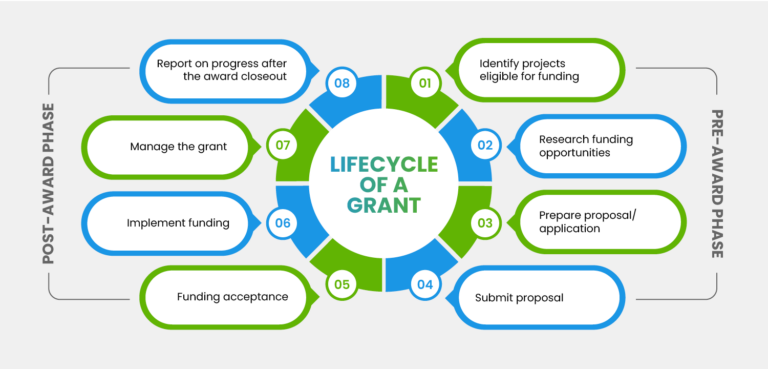
Written by Jerry Ashworth
Jerry Ashworth is the editor at Thompson Grants. Mr. Ashworth has served as the editor of these publications for more than 22 years. He has more than 35 years of journalism experience, including the last 30 years in the newsletter industry covering a range of topics from federal grants and single audits to electronic commerce and environmental issues. Mr. Ashworth has a Bachelor of Arts in Journalism degree from the University of Georgia and is a member of the Society of Professional Journalists. He can be connected with via LinkedIn.
Grant opportunities from government bodies or corporate partners can be a goldmine for growing charities when it comes to securing funding. But managing those grants? That’s where the real work begins.
Between juggling deadlines, ensuring compliance, and coordinating stakeholders, the grant management process can feel overwhelming for even the most seasoned fundraiser.
The good news? Grant management doesn’t have to be a burden. With some intentional strategies, your charity can make the entire process more efficient and successful. Here, we’ll walk through five practical best practices to ease your grant admin load and keep your team on track for funding success.
1. Build a Foundation with the Grant Management Cycle
To master grant management, start with a clear understanding of the grant management lifecycle. Thompson Grants’ comprehensive overview of the grant management cycle breaks it into three core phases:

- Pre-award: Researching opportunities, preparing applications, and submitting proposals.
- Award: Receiving notification, signing agreements, and setting internal expectations.
- Post-award: Reporting, monitoring, and closing out or renewing the grant.
Recognising these phases helps you assign responsibilities and anticipate needs. This structure also protects your team from missed deadlines and compliance slip-ups, supporting long-term funding success.
Many charities skip this strategic planning step and jump straight into writing proposals, but investing time in fully understanding each stage pays off. It empowers your team to be proactive rather than reactive—a crucial shift for managing multiple grants at once. If different staff are involved at different stages, having a documented process helps maintain continuity across personnel changes.
2. Standardise Grant Application and Reporting Processes
Time is a scarce asset for most fundraising teams, which is why standardisation is one of the most powerful tools at your disposal. Internal consistency makes external communication seamless and ensures you continue to receive the funding you need. Here’s how you can ensure a smooth, standardised process:
- Develop budget templates and logic models that align with common funder formats.
- Maintain a library of boilerplate text for standard grant sections.
- Align your internal reporting process to typical funder requirements for easy adaptation.
Also consider creating a grant “starter kit” for new team members. This could include past successful applications, evaluation rubrics, funder feedback, and samples of impact reports. Having everything in one place accelerates onboarding and boosts your team’s capability to hit the ground running. Small gains in efficiency here can save countless hours down the road, particularly in peak application seasons.
3. Strengthen Internal Collaboration
Grants are a team game, never a solo sport. Strong grant management requires cross-departmental collaboration across your nonprofit.
However, aligning everyone on the same page can be easier said than done. Get started by:
- Involving colleagues in finance, programmes, and communications from the outset.
- Appointing a grant lead to coordinate efforts and clarify everyone’s role at each lifecycle stage.
- Scheduling quarterly cross-team strategy sessions solely focused on reviewing your full grant pipeline, including wins, losses, pending decisions, and new prospects.
This collaborative approach prevents miscommunication and ensures no detail is overlooked. When everyone knows their role, from budgeting to storytelling, your chances of compliance and renewal increase dramatically. And, done well, these sessions build culture and spark fresh ideas across teams.
4. Prioritise Relationship Management with Funders
Great grant management is about more than just ticking boxes; it’s about cultivating trust and transparency with funders. Relationship management is essential for strengthening your network in the space and for winning repeat grant awards down the line.
- Share informal updates between reports: A quick email or call between reporting cycles can keep funders engaged and informed, showing that you value the relationship beyond formal deadlines.
- Use data and stories to communicate real impact, not just numbers: Combine quantitative outcomes with human-centered narratives to help funders see both the scale and substance of your work.
- Reach out proactively if challenges or delays arise: Transparency during setbacks builds trust—most funders appreciate honest communication and collaborative problem-solving.
- Personalise your communications, especially with large corporate and institutional funders: Tailor your messaging to reflect the funder’s specific interests and values, showing that you understand their goals and see them as a true partner.
Create a funder engagement plan as part of your grant management strategy. Include touchpoints like coffee catch-ups, sneak peeks at upcoming projects, or tailored thank-you messages from beneficiaries. These small actions make funders feel seen, not just solicited.
5. Use Tech and Metrics to Drive Smarter Decisions
Technology and real-time data can transform grant management from reactive to strategic. Using data not only ensures compliance, it’s also a powerful advocacy tool. When you can illustrate real outcomes across multiple grants, it strengthens external reporting and internal decision-making, too. Here’s how to balance tech and storytelling when writing grants:
- Use a centralised grant calendar to keep track of all deadlines and requirements.
- Leverage an online grant database to store proposals, track statuses, and manage documents.
- Choose solutions that integrate with your CRM, enabling smoother communications and linking grants with other fundraising activities.
- Automate reminders for key deadlines and reports to ensure nothing is missed.
- Track outcomes and monitor trends using dashboards, making your progress visible across the team.
- Harness AI tools for tasks like application drafting, eligibility checking, and automating standard reports.
If you don’t have a specialist platform yet, start small: tools like Excel or Asana can be configured to build a basic grants dashboard. As your needs grow, specialised platforms empower more automation, analysis, and collaboration.
Grant management doesn’t have to be complicated or overwhelming. With the right systems, collaborative culture, and use of technology, your charity can transform grant management into a strategic advantage.
Start with just one or two best practices that fit your organisation’s needs best. Even small steps can lead to smoother, more sustainable grant processes.
Are you a trusts, grants, or major donor fundraiser that’s looking for a way to define success, increase your impact, and reduce your workload? The Trusts and Major Donor conference is back for another year of shared learning, case studies, and best practice to help you focus on the areas that will help you succeed.